By Dan Beard
The pleasures of fishing are naturally and almost invariably connected in our minds with warm weather, particularly with Spring or the first coming of Summer, the bright freshness of bursting bud and new-opening wild blossom, and with those latter days in the Autumn over which the Summer King sheds his brightest glories.

Fig. 197.
Flip-Up Set.
But in our northern and easterly States, when old Winter has spread his mantle of frost and snow over the face of Nature, and hermetically sealed all the lakes and ponds under covers of ice, as an agreeable addition to the fun of skating, hardy, red-cheeked boys cut round holes in the thick ice, and through them rig their lines for pickerel fishing.
A very simple but ingenious contrivance enables a single fisherman to attend to quite a number of lines if the holes be all made within sight of the fisherman, the fish itself will give the signal for the particular line that requires attention.
The construction of this automatic fishing-tackle is so simple I that it may be made in a few moments by any one. The preceding illustration shows how it is arranged (Fig. 197). At the end of a light rod a foot or two in length is fastened a small signal flag; a piece of any bright-colored cloth answers the .purpose. This rod is bound with strong string at right angles to a second stick, which is placed across the hole, lying some inches upon the ice at either side; the flag also rests on the ice, leaving a short piece of the flag-rod projecting over the cross stick; to this short end the line and hook are fastened. The hook is baited with a live minnow or other suitable bait and lowered through the hole. The tackle is then in readiness for the capture of a pickerel. When the fish is hooked his struggles keep the flag flying (Fig. 198).

Fig. 198.
The Signal Flying